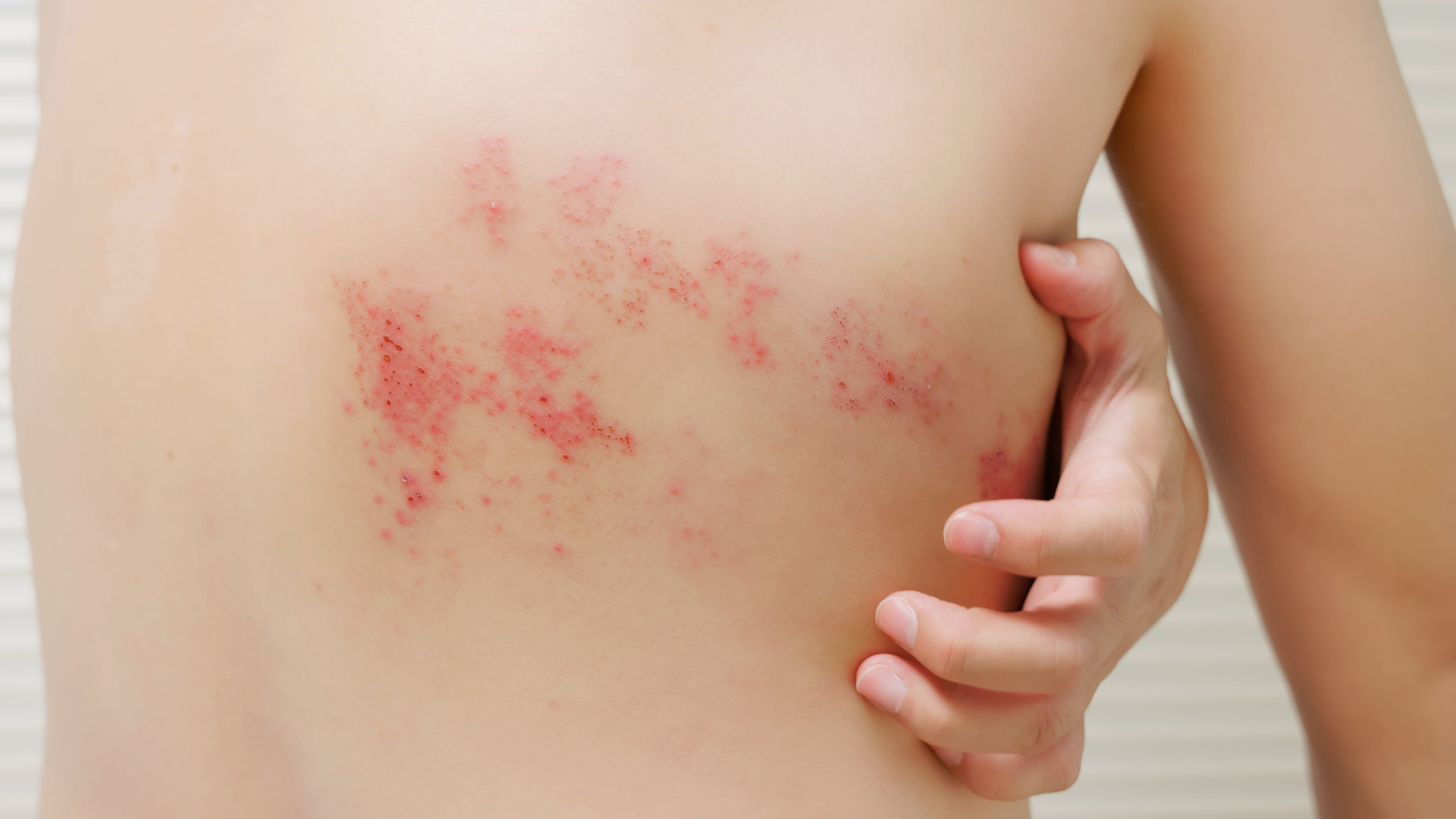
Key facts
- Shingles is an infection that causes a painful, blistering rash.
- It is most common in people over 50 years.
- Shingles can be treated with antiviral medicine.
- You can’t catch shingles from someone who has shingles, but you can get chickenpox from someone who has shingles if you have never had chickenpox or the chickenpox vaccine.
- The shingles vaccine helps prevent you from getting shingles.
What is shingles?
Shingles is a viral infection that causes a painful, blistering rash.
Who can get shingles?
You can only get shingles if you have had chickenpox. It’s possible to have had chickenpox with only minor symptoms.
Shingles can occur at any age. However, risk of shingles is higher in people:
- aged over 50 years
- with a weakened immune system
- who had chickenpox in their first year of life
About 1 in 3 people will develop shingles at some stage during their lifetime.
Usually, people have shingles only once in their lives. But sometimes, especially if you have a weakened immune system, you might get repeat infections.
What are the symptoms of shingles?
The initial symptoms of shingles are:
- a burning, tingling or itching sensation
- sensitivity to light
- headache
- tiredness
Rash
About 2 to 3 days after the initial symptoms, a rash will appear on sensitive skin. This rash usually appears on one side of your body around a skin nerve (called a dermatome).
At first, the rash consists of painful red bumps. These bumps quickly develop into fluid-filled blisters, which can be painful and itchy. These blisters will burst, and then heal into a crusty surface over 2 weeks.
Shingles rash can affect your:
- face
- chest
- back
- abdomen (tummy)
- pelvis
The rash usually lasts for around 10 days, but it can take several weeks to settle.
What causes shingles?
Shingles is caused by the reactivation of the varicella-zoster virus, which is the same virus that causes chickenpox.
How can I get shingles?
After having chickenpox, the virus stays in the nerve cells of your body but is not active. Shingles occurs when the virus becomes active again usually many years later.
The virus may be reactivated by stress, illness, immunosuppression, older age, trauma and radiotherapy. But shingles often occurs for no known reason.
You can’t catch shingles from someone who has shingles. But you can get chickenpox from someone who has shingles if you have never had chickenpox or the chickenpox vaccine.
The virus spreads if you have contact with fluid from the blisters on the person’s skin who has shingles or by using or touching their bedding, clothing or towels.
Unlike chickenpox, the shingles virus does not usually spread by coughing and sneezing. You can cover the shingles blisters with a dressing to help reduce the risk of passing the virus to others. Once the blisters crust over, the person is no longer infectious.

When should I see my doctor?
See your doctor if you are experiencing any symptoms of shingles.
You should see your doctor as soon as possible if you have symptoms of shingles and:
- are pregnant
- have a weakened immune system
How is shingles diagnosed?
To diagnose shingles, your doctor will ask you about your symptoms and examine your rash. They may test fluid from your blisters and take a blood sample from you. This can confirm if your rash is caused by shingles.
How is shingles treated?
There is no cure for shingles. But, starting antiviral therapy within 3 days of the rash appearing can reduce:
- the severity of your symptoms
- the risk of further complications
Your doctor can provide you with antiviral medicines.
If you are pregnant, talk to your doctor about whether antivirals are right for you.
Over-the counter medicines can be used for pain relief, such as:
- paracetamol
- non-steroidal anti-inflammatories
If over-the-counter medicines are not controlling your pain, your doctor may prescribe other medicines.
Managing shingles rash
There are several things you can do to help manage the condition.
Be sure to keep your rash dry and clean. After a bath or shower, dry your rash gently.
Try not to scratch your rash, as this can cause an infection or scarring.
You can reduce the discomfort from your rash by:
- wearing loose fitting clothes
- using a cooled towel on the affected area
If possible, cover your rash, to avoid spreading the virus to other people. Use a non-stick dressing if the area isn’t covered by light clothing.
Avoid antibiotic creams, gels, and sticking plasters (Band Aids) on the blisters. These may slow down the healing process.
Can shingles be prevented?
Getting vaccinated against shingles reduces your chance of developing the condition. The shingles vaccine is recommended for:
- everyone aged 50 years and over
- people aged 18 years or older with a weak immune system
- people over 50 years who have contact with someone who has a weak immune system
People who have a weakened immune system includes people who:
- have HIV and AIDS
- are having cancer treatment
- have had an organ transplant or bone marrow transplant
- are receiving other treatment that affects their immune system
Vaccination does not guarantee that you won’t get shingles, but it will reduce your chance of developing the condition.
The vaccine used to protect you against shingles is not the same as the vaccine used to protect against chickenpox. Read more about the chickenpox vaccine here.
What are the recommendations for the shingles vaccine?
Vaccination is your best protection against shingles. See more details about the shingles vaccine in the table below.
What age is vaccination recommended? | The shingles vaccination is recommended for:
|
How many doses are needed? | 2 doses |
How is it given? | Injection |
Is it free? | Shingrix is free for:
For everyone else, there is a cost for this vaccine. |
Common side effects | The vaccine is safe. Side effects may include:
|
Talk to your doctor about what is best for you. Ask your doctor if you are eligible for free vaccination based on your situation or location.
How is the spread of shingles prevented?
Shingles is a nationally notifiable disease. If you are diagnosed with shingles, your doctor will tell your local public health authority. They may ask who you have been in contact with, to help prevent the disease from spreading.
If you have shingles, you can also help prevent it from spreading by avoiding:
- sharing towels
- playing contact sports
- swimming
If you have shingles, avoid contact with people who may be more at risk.
Be sure to wash your hands often and practice good hygiene.
Complications of shingles
In many people, shingles gets better without any complications. However, other people may experience complications.
If you have shingles rash and it becomes infected, you may need to take antibiotics. A rare complication may include scarring from bacterial infection, and post inflammatory hypopigmentation, which is a loss of pigmentation.
Shingles occurring in the eye area could result in temporary or permanent vision loss. If you do have shingles in your eye, your doctor may refer you to an eye specialist for treatment.
Shingles can also cause facial drooping and Ramsay Hunt Syndrome. Visit your doctor if you have symptoms of Ramsay Hunt syndrome, which include:
- rash around the ear
- earache
- hearing loss
- dizziness
Post-herpetic neuralgia
For 1 in 10 people, the pain and tingling of shingles can last for months or even years. This is called post-herpetic neuralgia, and is more common in people over 50 years



